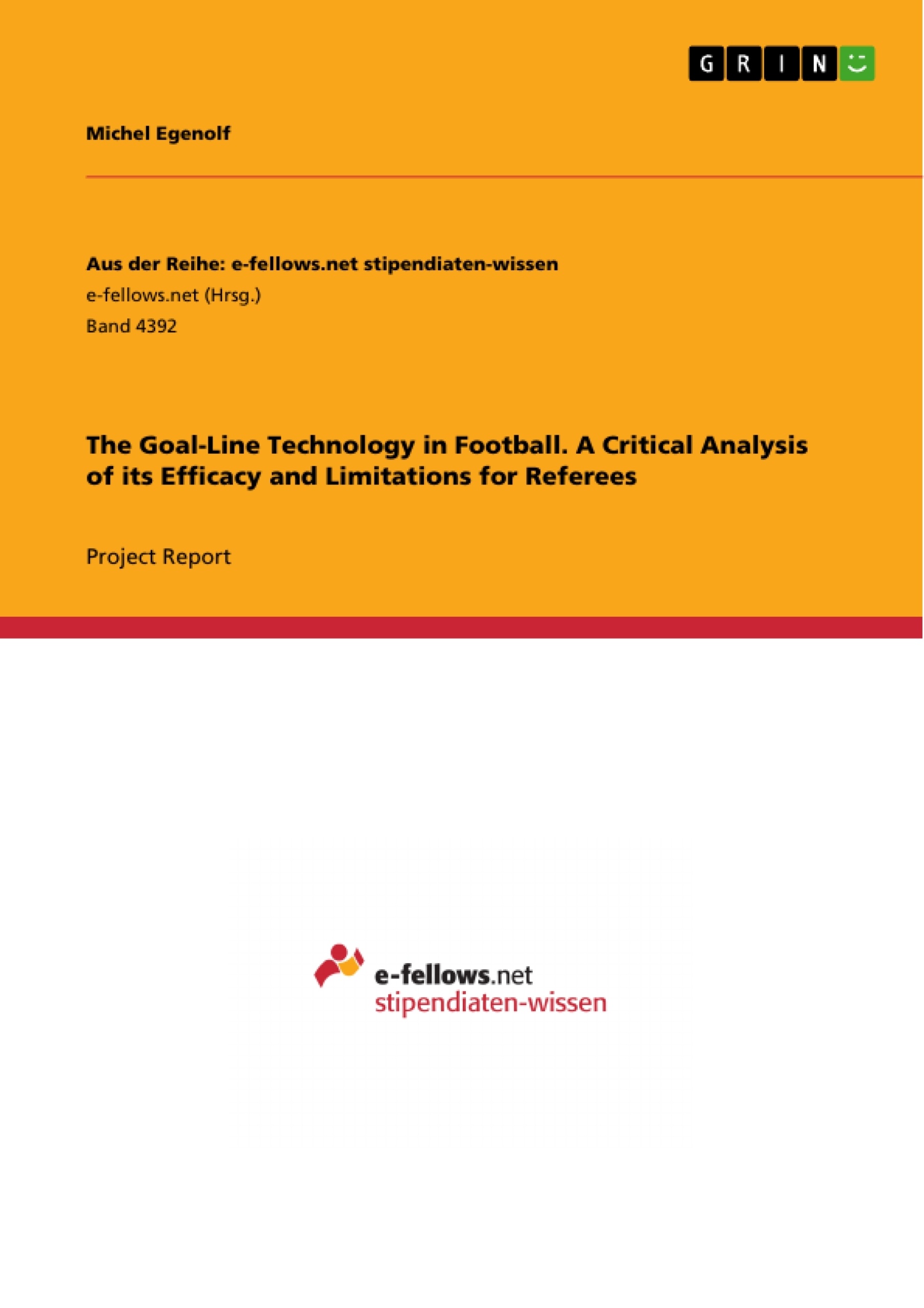This academic paper takes a critical look at various aspects of goal-line technology in football. The main focus is on explaining how the technology works. The motivation for the introduction of this technology was due to several incorrect decisions by referees when a goal was scored. After lengthy discussions, the national and international associations decided to introduce camera-based goal-line technology.
Fourteen cameras are attached to the roof of the football stadium to check disputed situations. Seven cameras are aimed at each of the two penalty areas and film the ball as soon as it enters the penalty area. The camera images are then transmitted to a computer via fibre-optic-cable. The computer then uses detection software to calculate the exact position of the ball in relation to the goal line. As soon as the ball is behind the goal line, a signal is sent to the referee's watch on the field. With the help of the technology, the referee on the field can make the right decision even in tight situations.
Nevertheless, it has been shown that the technology also makes mistakes despite its high level of accuracy; examples of this from football are discussed in detail. The advantages and disadvantages of the technology are then discussed in a critical evaluation, which concludes that the combination of humans and digital technology remains superior to the use of technology alone.
Inhaltsverzeichnis (Table of Contents)
- Abstract
- Table of illustrations
- 1. Introduction
- 2. Main part
- 2.1. Reasons for the introduction of goal-line technology
- 2.2. Where is goal-line technology used?
- 2.3. The cost of goal-line technology
- 2.4. How does goal-line technology work?
- 2.5. How does the ball detection software work?
- 2.6. Evaluation of Goal Line Technology Accuracy
- 2.7. Reliability Under Various Environmental Conditions
- 2.8. Comparison with Traditional Officiating Methods
- 2.9. Positive development thanks to goal-line technology
- 2.10. Errors in goal-line technology
- 3. Conclusion
- 3.1. Critical evaluation
- 4. Literature sources
- 5. Image Sources
- 6. Appendix
- 6.1. Al directory
Zielsetzung und Themenschwerpunkte (Objectives and Key Themes)
This academic paper examines the implementation and effectiveness of goal-line technology in football, focusing on its technical operation and impact on the sport.
- The reasons for introducing goal-line technology, stemming from the need to address historical errors and improve refereeing accuracy.
- The technical workings of goal-line technology, including the camera system, ball detection software, and communication processes.
- The benefits and drawbacks of goal-line technology, assessing its accuracy, reliability, and impact on the game.
- The evolution of football refereeing in light of technological advancements, comparing traditional methods with the role of goal-line technology.
- The significance of goal-line technology in enhancing the integrity and fairness of the sport.
Zusammenfassung der Kapitel (Chapter Summaries)
- Introduction: This chapter presents the historical context of goal-line technology, highlighting famous instances of refereeing errors and emphasizing the need for technological solutions.
- Main part: Reasons for the introduction of goal-line technology: This section delves into the motivations behind the adoption of goal-line technology, referencing specific instances of disputed goals and the increasing speed and complexity of the game.
- Main part: Where is goal-line technology used?: This section explores the widespread adoption of goal-line technology across different football leagues and tournaments.
- Main part: The cost of goal-line technology: This section analyzes the financial implications of installing and maintaining goal-line technology in football stadiums.
- Main part: How does goal-line technology work?: This section provides a detailed explanation of the technical components of goal-line technology, outlining the camera system, ball detection software, and communication processes.
- Main part: How does the ball detection software work?: This section delves deeper into the specific algorithms and processes employed by the ball detection software used in goal-line technology.
- Main part: Evaluation of Goal Line Technology Accuracy: This section examines the accuracy of goal-line technology, analyzing its performance in identifying goal events and potential limitations.
- Main part: Reliability Under Various Environmental Conditions: This section investigates the robustness of goal-line technology in different weather conditions and stadium environments.
- Main part: Comparison with Traditional Officiating Methods: This section compares goal-line technology with traditional refereeing techniques, exploring the advantages and disadvantages of each approach.
- Main part: Positive development thanks to goal-line technology: This section explores the positive impact of goal-line technology on football, including its contribution to improving refereeing decisions and promoting fair play.
- Main part: Errors in goal-line technology: This section examines potential errors and limitations associated with goal-line technology, acknowledging its imperfect nature and instances where it may fail to provide accurate results.
Schlüsselwörter (Keywords)
The main keywords and focus topics of this text include: goal-line technology, football, refereeing, accuracy, reliability, technology in sports, human error, technological advancements, football regulations, camera systems, ball detection software, image processing, football history, disputed goals, sporting integrity.
- Quote paper
- Michel Egenolf (Author), 2024, The Goal-Line Technology in Football. A Critical Analysis of its Efficacy and Limitations for Referees, Munich, GRIN Verlag, https://www.hausarbeiten.de/document/1453296


